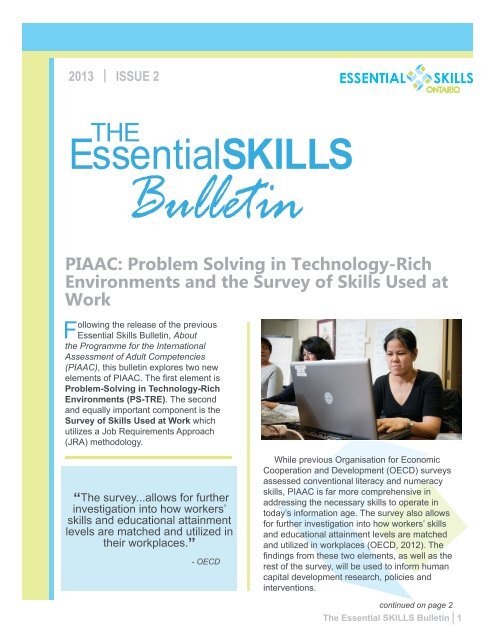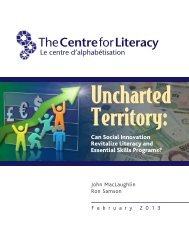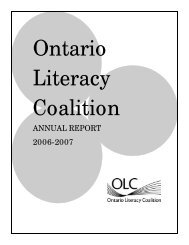Create successful ePaper yourself
Turn your PDF publications into a flip-book with our unique Google optimized e-Paper software.
2013 ISSUE 2THE<strong>Essential</strong>SKILLSBulletin<strong>PIAAC</strong>: Problem Solving in Technology-RichEnvironments and the Survey of <strong>Skills</strong> Used atWorkFollowing the release of the previous<strong>Essential</strong> <strong>Skills</strong> Bulletin, Aboutthe Programme for the InternationalAssessment of Adult Competencies(<strong>PIAAC</strong>), this bulletin explores two newelements of <strong>PIAAC</strong>. The first element isProblem-Solving in Technology-RichEnvironments (PS-TRE). The secondand equally important component is theSurvey of <strong>Skills</strong> Used at Work whichutilizes a Job Requirements Approach(JRA) methodology.“The survey...allows for furtherinvestigation into how workers’skills and educational attainmentlevels are matched and utilized intheir workplaces.”- OECDWhile previous Organisation for EconomicCooperation and Development (OECD) surveysassessed conventional literacy and numeracyskills, <strong>PIAAC</strong> is far more comprehensive inaddressing the necessary skills to operate intoday’s information age. The survey also allowsfor further investigation into how workers’ skillsand educational attainment levels are matchedand utilized in workplaces (OECD, 2012). Thefindings from these two elements, as well as therest of the survey, will be used to inform humancapital development research, policies andinterventions.continued on page 2The <strong>Essential</strong> SKILLS Bulletin 1
Building on the work of Autor, Levy andMurnane, the OECD - through the <strong>PIAAC</strong> survey- is using the categorization of ‘expert thinking’to assess the complex problem solving skillsnecessary for an information-based economy(OECD, 2012). The OECD has developeddiagnostic questions that are used to measureproblem solving abilities directly linked tothe use of ICT in real world contexts. Thisincludes the ability to use digital technology,communication tools and networks, acquire andevaluate information, communicate with othersand perform practical tasks.The assessment of PS-TREs in <strong>PIAAC</strong> is notdesigned to assess and measure specific ICTskills and/or computer or digital literacy – theseskills are presupposed – but instead measuresthe cognitive skills through problem solvingabilities that are used and necessary to functionsuccessfully in today’s information age. Unlikedigital skills and ICT skills, which typically entailthe basic use of devices like a mouse, keyboard,touch screens and other digital displays (e.g.bank machines), the assessment items of PS-TREs are designed to consider the cognitivedimensions of problem solving as the primaryobjective and the use of ICT skills, secondary(OECD, 2012).The PS-TREs element in <strong>PIAAC</strong> is ambitiousin its aims, as it is more than an assessment ofcomputer literacy or digital skills - it is designedto expand our understanding of the depth andcomplexity of cognitive skills used to solveproblems in technology-rich environments.Addressing <strong>Skills</strong>Utilization andMismatch through<strong>PIAAC</strong>information based and skills oriented, skillsrelated policies are increasingly becoming moreprominent and the domain of skills utilizationand/or skill mismatches has become broader(Buchanan, J. et al, 2010).In the past, human capital – a measure of theeconomic value of an employee’s skill set – wasmainly observed through a supply-side lens,with educational credentials and/or qualificationsbeing the main focal point. However, over thepast decade, the focus of human capital hasshifted toward an interest in the analysis ofeducational mismatches to identify whetherworkers and/or the general population wereunder or over-educated in relation to jobs theywere employed in or that were accessible tothem.Furthermore, many academic and policy circlesare now beginning to focus on skills mismatcheswhich includes skills utilization (the actual useof skills needed in the workplace) and demandsidefunctions of the labour market (Desjardins& Rubenson, 2011). In other words, the notionof skills utilization is based on a broaderconceptualization of the skills workers needin their jobs and how, in turn, those skills aredeployed in working environments. This conceptallows for a deeper investigation into the skillsmatches or mismatches and their relationshipto education, sectors, occupations and/or othersocioeconomic factors. Although skills utilizationis a concept that is relatively new and not alwayswell understood by employers and employees,a definition is emerging which attempts to marrythe concept to government policy objectives.The <strong>PIAAC</strong> results are of importance togovernments and industry, as they sharea common interest in developing a betterunderstanding of the relationships betweenskills, education, productivity, economiccompetitiveness and how we can make betteruse of skills. As our economy becomes more4 The <strong>Essential</strong> SKILLS Bulletin 2013 Issue 2
The Survey of <strong>Skills</strong>Used at Work and JobRequirements ApproachAs the concepts of skills utilization and/or skillsmismatch becomes more accepted and broaderin scope, so do the analytical tools associatedwith their measurement and analysis. In OECD’sprevious survey, ALLS, the basic measures offoundational skills and the use of skills at workwere correlated. Through <strong>PIAAC</strong>, the OECD hasgathered far more comprehensive data that willbe able to go much further in the examination ofskills utilization and skills matches. In order tomeasure a broad range of generic work skills,<strong>PIAAC</strong> is using the Job Requirements Approach(JRA), a methodology that has been testedand utilized in the United States for the O*NETsystem, the United Kingdom’s <strong>Skills</strong> Surveyand the Italian Organisation’s Learning andCompetences Survey (Keese, 2009).Based on a self-assessment, the JRA approachasks workers the importance of specific jobrequirements in terms of types and levels ofgeneric skills that are used in workplaces.This includes reading, numeracy, physicalskills, mastery of information technology,communication, presentation and teamworkingskills. <strong>PIAAC</strong>’s JRA module providesinternationally comparable data that will shedlight on the relationship between the distributionof generic skills used in the workplace andhow they relate to education and othersocioeconomic factors. More specially, it willimprove our understanding of the relationshipsbetween labour market outcomes, the typesand levels of generic skills that attract a highervalue in the workforce, sectors and occupations(low-skilled and high-skilled jobs), the use oftechnology, as well as how our education andtraining system contributes to the developmentof in-demand skills.<strong>Skills</strong> Measured in the Job Requirements Approach (JRA)Cognitive <strong>Skills</strong>Reading, writing,maths, IT, problemsolvingInteraction/Social<strong>Skills</strong>Influence, selfdirection,horizontalinteraction, clientinteractionKey Workplace<strong>Skills</strong>Physical <strong>Skills</strong>Stamina,strength,dexteritySocial <strong>Skills</strong>Required to learnthings, keep up to date,help others learnAdapted from Keese, M. (2009). Matching <strong>PIAAC</strong>’s job requirements approach with an employers survey. Cedefop ExpertsWorkshop on “Employers’ Survey on <strong>Skills</strong> Needs: Feasibility Work”. Milan. [PowerPoint Presentation].Slide 4.The <strong>Essential</strong> SKILLS Bulletin 2013 Issue 25
What do PS-TRE andJRA Mean for <strong>Ontario</strong>?The new elements of PS-TRE and JRA willprovide <strong>Ontario</strong> with a broader understandingof the cognitive skills that are used intechnologically-rich environments and the linksbetween generic workplace skills and labourmarket outcomes, jobs and the employmentand training system. As skill demands alterin response to technological advancements,access to reliable aggregate data that capturesthe levels, types and distribution of skills inrelation to socioeconomic outcomes canprovide policy makers in <strong>Ontario</strong> with the kind ofinformation that is necessary for more informedpolicy and programming decisions in educationand training. The findings of <strong>PIAAC</strong> will provide<strong>Ontario</strong> with a broader and more detailedunderstanding of human capital developmentand its relationship to social and economicoutcomes.What do PS-TRE andJRA Mean for Literacyand Basic <strong>Skills</strong>Programs?The new <strong>PIAAC</strong> framework offers an enhancedversion of what literacy, numeracy and problemsolving are in the 21 st century. When thefindings from <strong>PIAAC</strong> are released, this informedevidence will give programs and practitionersanswers for two of the biggest challenges theyface:First, how do we teach technology skills in amanner that reaches beyond specific computerskills, operations and software? The elementof PS-TRE and its associated frameworkprovide comprehensive understatings of howtechnology is used and its relation to essentialcognitive skills. This framework can be used toas resource to inform ongoing development ofcurriculum with particular exercises that focuson the competencies required for using digitaltechnology.Second, <strong>PIAAC</strong> may provide answers to thequestion of what kinds of generic skills arestill needed for today’s jobs. Different fromtraditional job search skills, <strong>PIAAC</strong>’s Surveyof <strong>Skills</strong> Used at Work may offer importantinsights into what types and levels of genericskills are used in modern workplaces. Thisinformation can be used by programs to focuson competencies and tasks that are increasinglyrequired and utilized by the workforce. This isparticularly important for learners and programswho have an interest in building the skillsnecessary for employment and job progression.In the coming months, <strong>Essential</strong> <strong>Skills</strong><strong>Ontario</strong> will explore, discuss and investigatethe interconnections between literacy andessential skills (LES), PS-TRE, job-specificskills, quality programming and their connectionto geographical location (place), labour marketoutcomes and economic development.6 The <strong>Essential</strong> SKILLS Bulletin 2013 Issue 2
BIBLIOGRAPHYAutor, D. H., Levy, F., & Murnane, R. J. (2003).The skill content of recent technological change:An empirical exploration. Quarterly Journal ofEconomics, 118 (4). Oxford, UK: Oxford UniversityPress.Buchanan, J. et al. (2010). <strong>Skills</strong> demand andutilisation: An international review of approachesto measurement and policy development.OECD Local Economic and EmploymentDevelopment (LEED) Working Papers, 2010/04,OECD Publishing. Retrieved from: http://dx.doi.org/10.1787/5km8zddfr2jk-enDesjardins, R. & Rubenson, K. (2011). An analysisof skill mismatch using direct measures of skills.OECD Education Working Papers, No. 63,OECD Publishing. Retrieved from: http://dx.doi.org/10.1787/5kg3nh9h52g5-enLevy, F., & Murnane, R. J. (2004). The new divisionof labor: How computers are creating the next jobmarket. Princeton, NJ: Princeton University Press.OECD. (2012), Literacy, numeracy, and problemsolving in technology-rich environments:Framework for the OECD survey of adult skills.OECD Publishing. Retrieved from: http://dx.doi.org/10.1787/9789264128859-en<strong>PIAAC</strong> Expert Group in Problem Solving inTechnology-Rich Environments. (2009). <strong>PIAAC</strong>problem solving in technology-rich environments: Aconceptual framework. OECD Education WorkingPapers, No. 36, OECD Publishing. Retrieved from:http://dx.doi.org/10.1787/220262483674Keese, M. (2009), Matching <strong>PIAAC</strong>’s jobrequirements approach with an employers survey.Cedefop Experts Workshop on “Employers’ Surveyon <strong>Skills</strong> Needs: Feasibility Work”. Milan. [PowerPoint Slides]. Slide 4. Retrieved from: http://www.cedefop.europa.eu/EN/Files/4497-att1-1-keese_matching_piaacs_job_requirements_approach.pdfFor comments and inquiries, please contact:<strong>Essential</strong> <strong>Skills</strong> <strong>Ontario</strong>65 Wellesley St. East, Suite 503Toronto, <strong>Ontario</strong>M4Y 1G7Phone: (416) 963-5787Email: info@essentialskillsontario.caWebsite: www.essentialskillsontario.caThe <strong>Essential</strong> SKILLS Bulletin 2013 Issue 27




